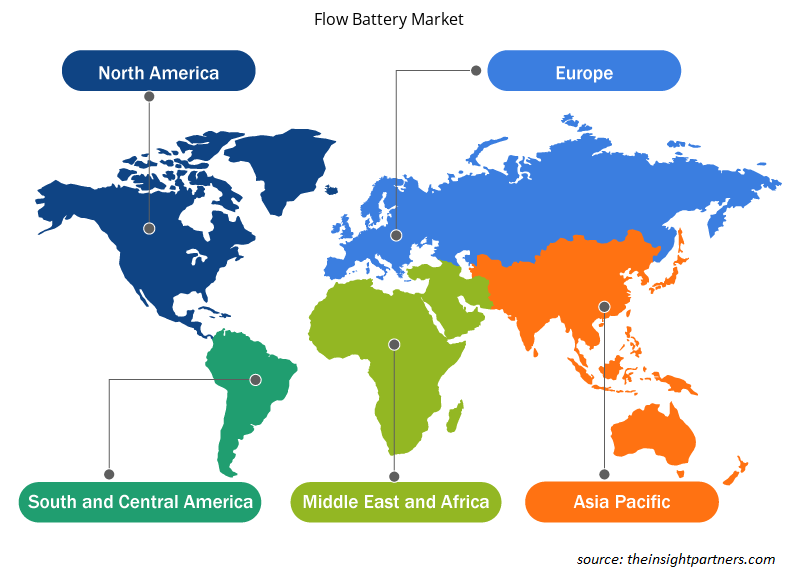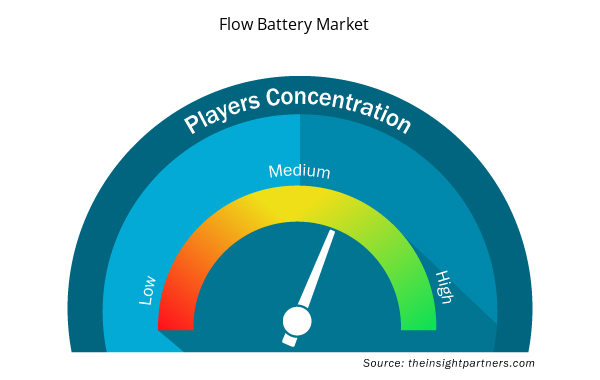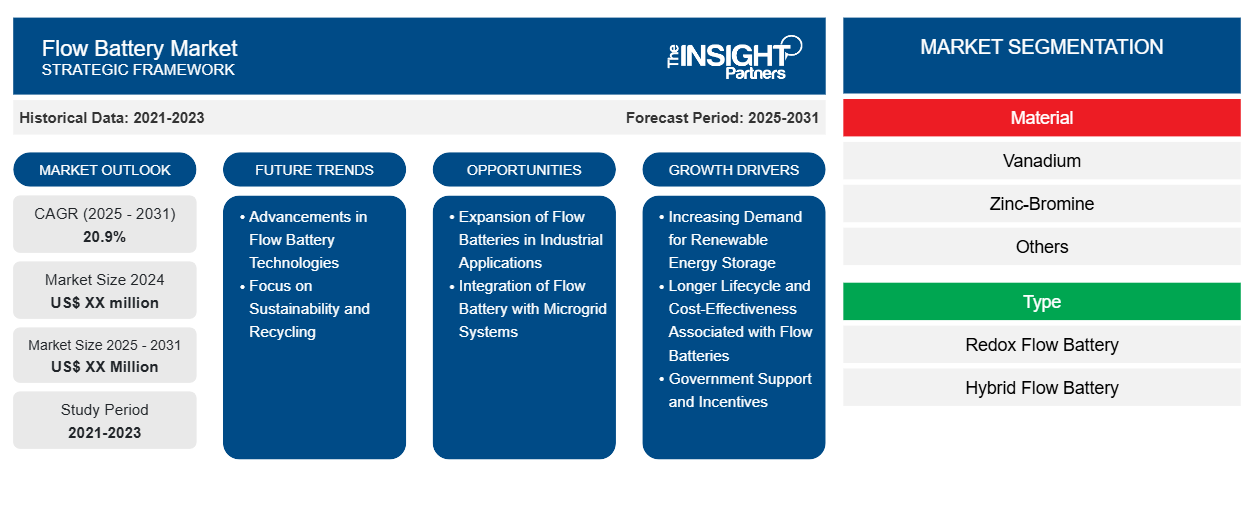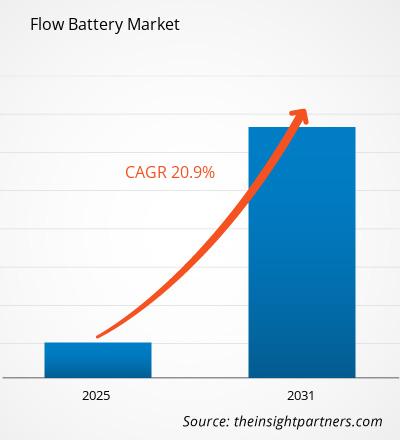フロー電池市場は、2024年から2031年にかけて20.9%のCAGRで成長すると予想されており、市場規模は2024年のXX百万米ドルから2031年にはXX百万米ドルに拡大すると予想されています。
レポートは、材料(バナジウム、亜鉛臭素、その他)、タイプ(レドックスフロー電池、ハイブリッドフロー電池)、ストレージ(大規模、コンパクト)、アプリケーション(軍事、公共事業、商業、工業、その他)別にセグメント化されています。グローバル分析は、地域レベルと主要国でさらに細分化されています。レポートは、上記の分析とセグメントに対して米ドルでの価値を提供します。
報告書の目的
The Insight Partners によるフロー バッテリー市場レポートは、現在の状況と将来の成長、主な推進要因、課題、機会を説明することを目的としています。これにより、次のようなさまざまなビジネス ステークホルダーに洞察が提供されます。
- テクノロジープロバイダー/メーカー: 進化する市場の動向を理解し、潜在的な成長機会を把握することで、情報に基づいた戦略的意思決定が可能になります。
- 投資家: 市場の成長率、市場の財務予測、バリュー チェーン全体に存在する機会に関する包括的な傾向分析を実施します。
- 規制機関: 市場の濫用を最小限に抑え、投資家の信用と信頼を維持し、市場の完全性と安定性を維持することを目的として、市場における政策と警察活動を規制します。
フロー電池市場のセグメンテーション
材料
- バナジウム
- 亜鉛臭素
- その他
タイプ
- レドックスフロー電池
- ハイブリッドフロー電池
ストレージ
- 大規模
- コンパクト
応用
- 軍隊
- ユーティリティ
- コマーシャル
- 産業
- その他
要件に合わせてレポートをカスタマイズする
このレポートの一部、国レベルの分析、Excelデータパックなど、あらゆるレポートを無料でカスタマイズできます。また、スタートアップや大学向けのお得なオファーや割引もご利用いただけます。
- このレポートの主要な市場動向を入手してください。この無料サンプルには、市場動向から見積もりや予測に至るまでのデータ分析が含まれます。
フロー電池市場の成長要因
- 再生可能エネルギー貯蔵の需要増加: 太陽光や風力などの再生可能エネルギー源の高速化により、フロー電池の需要が新たなピークを迎え、よりスケーラブルな効率的な貯蔵が求められています。エネルギー転換のペースが加速する中、再生可能エネルギーのグリッド統合においてフロー電池の最大の有用性が発揮されます。
- フロー バッテリーの寿命が長く、コスト効率が高い: フロー バッテリーは、従来のバッテリー技術よりも寿命が長く、総所有コストが低くなっています。フロー バッテリーは、劣化がほとんどなく、何千回も充電と放電ができるため、大規模なアプリケーションに最適です。長寿命であるため、交換コストが低く、結果として全体的な経済的実現可能性が高まります。業界や公共事業体は、エネルギー貯蔵ソリューションとしてフロー バッテリー システムに投資することになります。
- 政府の支援とインセンティブ: さまざまな政府がインセンティブや補助金を通じてエネルギー貯蔵システムを推進しています。炭素削減とエネルギー効率改善の政策は、フロー電池に有利な環境を提供します。このようなインセンティブは、この分野の研究開発を刺激し、技術の向上とフロー電池技術への投資の増加を継続的に促し、市場の成長を促進します。
フロー電池市場の将来動向
- フロー バッテリー技術の進歩: フロー バッテリー技術の研究開発は、革新を生み出し続けています。有機フロー バッテリーなどの新しい材料と化学の革新により、効率性の向上、エネルギー密度の向上、コストの削減が実現しています。この傾向により、フロー バッテリーは従来のエネルギー貯蔵システムに代わる競争力のある代替手段となり、市場の成長への新たな道筋となるため、さまざまな用途でさらに魅力的なものとなっています。
- 持続可能性とリサイクルに焦点を当てる: リサイクルを主な焦点とした持続可能なフロー バッテリー: 持続可能性はフロー バッテリー市場の主な原動力であり続け、メーカーが「グリーン プラクティス」と「持続可能な材料」を採用する傾向が高まっています。グローバルな持続可能性の目標に基づいてより効率的かつ持続可能な「グリーン システム」への移行により、フロー バッテリー技術のブランド評判と顧客ロイヤルティがさらに強化されます。
フロー電池市場の機会
- 産業用途におけるフロー電池の拡大: フロー電池の巨大な市場機会は、産業における信頼性の高い電力貯蔵のニーズにあります。製造業や鉱業などの産業用途では、電力を供給し負荷を管理するために安定した電力供給が必要です。フロー電池は目的を満たすために適用できるため、企業はエネルギーを節約しながらプロセスを改善できます。このような傾向は、他の産業用途向けにカスタム構築されたフロー電池システムを作成することで活用できます。
- フロー バッテリーとマイクログリッド システムの統合: フロー バッテリーは、エネルギーの回復力と持続可能性を高めるマイクログリッド システムで大きなチャンスを秘めています。コミュニティや企業が電力生産と貯蔵の分散化を模索する中、信頼性の高いバックアップ電源の形成と供給管理におけるフロー バッテリーの将来的な影響は、大きく影響を受けることになります。この点で、メーカーがこの新しい市場に参入する方法の 1 つは、マイクログリッド アプリケーション向けに設計されたフロー バッテリー ソリューションを開発することです。
フロー電池市場の地域別分析
予測期間を通じてフロー バッテリー市場に影響を与える地域的な傾向と要因は、Insight Partners のアナリストによって徹底的に説明されています。このセクションでは、北米、ヨーロッパ、アジア太平洋、中東、アフリカ、南米、中米にわたるフロー バッテリー市場のセグメントと地理についても説明します。

- フロー電池市場の地域別データを入手
フロー電池市場レポートの範囲
| レポート属性 | 詳細 |
|---|---|
| 2024年の市場規模 | XX百万米ドル |
| 2031年までの市場規模 | XX百万米ドル |
| 世界のCAGR(2025年~2031年) | 20.9% |
| 履歴データ | 2021-2023 |
| 予測期間 | 2025-2031 |
| 対象セグメント | 素材別
|
| 対象地域と国 | 北米
|
| 市場リーダーと主要企業プロフィール |
|
フロー電池市場のプレーヤー密度:ビジネスダイナミクスへの影響を理解する
フロー バッテリー市場は、消費者の嗜好の変化、技術の進歩、製品の利点に対する認識の高まりなどの要因により、エンド ユーザーの需要が高まり、急速に成長しています。需要が高まるにつれて、企業は提供内容を拡大し、消費者のニーズを満たすために革新を起こし、新たなトレンドを活用し、市場の成長をさらに促進しています。
市場プレーヤー密度とは、特定の市場または業界内で活動している企業または会社の分布を指します。これは、特定の市場スペースに、その規模または総市場価値と比較して、どれだけの競合相手 (市場プレーヤー) が存在するかを示します。
フロー電池市場で事業を展開している主要企業は次のとおりです。
- エレスターBV
- ESS株式会社
- 株式会社H2
- ケミワット
- ナノフローセルホールディングス株式会社
免責事項:上記の企業は、特定の順序でランク付けされていません。

- フロー電池市場のトップキープレーヤーの概要を入手
主なセールスポイント
- 包括的なカバレッジ: レポートでは、フロー バッテリー市場の製品、サービス、タイプ、エンド ユーザーの分析を包括的にカバーし、全体的な概要を提供します。
- 専門家による分析: レポートは、業界の専門家とアナリストの深い理解に基づいてまとめられています。
- 最新情報: このレポートは、最新の情報とデータの傾向を網羅しているため、ビジネスの関連性を保証します。
- カスタマイズ オプション: このレポートは、特定のクライアント要件に対応し、ビジネス戦略に適切に適合するようにカスタマイズできます。
したがって、フロー バッテリー市場に関する調査レポートは、業界のシナリオと成長の見通しを解読して理解する道の先導役となる可能性があります。正当な懸念事項がいくつかあるかもしれませんが、このレポートの全体的な利点は欠点を上回る傾向があります。
- 過去2年間の分析、基準年、CAGRによる予測(7年間)
- PEST分析とSWOT分析
- 市場規模価値/数量 - 世界、地域、国
- 業界と競争環境
- Excel データセット


- Volumetric Video Market
- Compounding Pharmacies Market
- Artificial Turf Market
- Medical Devices Market
- Vision Guided Robotics Software Market
- Small Satellite Market
- Biopharmaceutical Contract Manufacturing Market
- 3D Mapping and Modelling Market
- Electronic Health Record Market
- Electronic Data Interchange Market

Report Coverage
Revenue forecast, Company Analysis, Industry landscape, Growth factors, and Trends

Segment Covered
This text is related
to segments covered.

Regional Scope
North America, Europe, Asia Pacific, Middle East & Africa, South & Central America

Country Scope
This text is related
to country scope.
よくある質問
Some of the customization options available based on the request are an additional 3-5 company profiles and country-specific analysis of 3-5 countries of your choice. Customizations are to be requested/discussed before making final order confirmation as our team would review the same and check the feasibility
The report can be delivered in PDF/PPT format; we can also share excel dataset based on the request
The major factors driving the flow battery market are:
1. Growing Demand for Energy Storage Solutions
2. Government Initiatives and Policies
Focus on Sustainability is anticipated to play a significant role in the global flow battery market in the coming years
The Flow Battery Market is estimated to witness a CAGR of 20.9% from 2023 to 2031
-
Trends and growth analysis reports related to Energy and Power : READ MORE..
1. Elestor BV
2. ESS, Inc
3. H2, Inc.
4. Kemiwatt
5. nanoFlowcell Holdings Ltd
6. Primus Power
7. redT energy plc
8. SCHMID Group
9. Sumitomo Electric Industries, Ltd.
10. Vionx Energy
The Insight Partners performs research in 4 major stages: Data Collection & Secondary Research, Primary Research, Data Analysis and Data Triangulation & Final Review.
- Data Collection and Secondary Research:
As a market research and consulting firm operating from a decade, we have published and advised several client across the globe. First step for any study will start with an assessment of currently available data and insights from existing reports. Further, historical and current market information is collected from Investor Presentations, Annual Reports, SEC Filings, etc., and other information related to company’s performance and market positioning are gathered from Paid Databases (Factiva, Hoovers, and Reuters) and various other publications available in public domain.
Several associations trade associates, technical forums, institutes, societies and organization are accessed to gain technical as well as market related insights through their publications such as research papers, blogs and press releases related to the studies are referred to get cues about the market. Further, white papers, journals, magazines, and other news articles published in last 3 years are scrutinized and analyzed to understand the current market trends.
- Primary Research:
The primarily interview analysis comprise of data obtained from industry participants interview and answers to survey questions gathered by in-house primary team.
For primary research, interviews are conducted with industry experts/CEOs/Marketing Managers/VPs/Subject Matter Experts from both demand and supply side to get a 360-degree view of the market. The primary team conducts several interviews based on the complexity of the markets to understand the various market trends and dynamics which makes research more credible and precise.
A typical research interview fulfils the following functions:
- Provides first-hand information on the market size, market trends, growth trends, competitive landscape, and outlook
- Validates and strengthens in-house secondary research findings
- Develops the analysis team’s expertise and market understanding
Primary research involves email interactions and telephone interviews for each market, category, segment, and sub-segment across geographies. The participants who typically take part in such a process include, but are not limited to:
- Industry participants: VPs, business development managers, market intelligence managers and national sales managers
- Outside experts: Valuation experts, research analysts and key opinion leaders specializing in the electronics and semiconductor industry.
Below is the breakup of our primary respondents by company, designation, and region:

Once we receive the confirmation from primary research sources or primary respondents, we finalize the base year market estimation and forecast the data as per the macroeconomic and microeconomic factors assessed during data collection.
- Data Analysis:
Once data is validated through both secondary as well as primary respondents, we finalize the market estimations by hypothesis formulation and factor analysis at regional and country level.
- Macro-Economic Factor Analysis:
We analyse macroeconomic indicators such the gross domestic product (GDP), increase in the demand for goods and services across industries, technological advancement, regional economic growth, governmental policies, the influence of COVID-19, PEST analysis, and other aspects. This analysis aids in setting benchmarks for various nations/regions and approximating market splits. Additionally, the general trend of the aforementioned components aid in determining the market's development possibilities.
- Country Level Data:
Various factors that are especially aligned to the country are taken into account to determine the market size for a certain area and country, including the presence of vendors, such as headquarters and offices, the country's GDP, demand patterns, and industry growth. To comprehend the market dynamics for the nation, a number of growth variables, inhibitors, application areas, and current market trends are researched. The aforementioned elements aid in determining the country's overall market's growth potential.
- Company Profile:
The “Table of Contents” is formulated by listing and analyzing more than 25 - 30 companies operating in the market ecosystem across geographies. However, we profile only 10 companies as a standard practice in our syndicate reports. These 10 companies comprise leading, emerging, and regional players. Nonetheless, our analysis is not restricted to the 10 listed companies, we also analyze other companies present in the market to develop a holistic view and understand the prevailing trends. The “Company Profiles” section in the report covers key facts, business description, products & services, financial information, SWOT analysis, and key developments. The financial information presented is extracted from the annual reports and official documents of the publicly listed companies. Upon collecting the information for the sections of respective companies, we verify them via various primary sources and then compile the data in respective company profiles. The company level information helps us in deriving the base number as well as in forecasting the market size.
- Developing Base Number:
Aggregation of sales statistics (2020-2022) and macro-economic factor, and other secondary and primary research insights are utilized to arrive at base number and related market shares for 2022. The data gaps are identified in this step and relevant market data is analyzed, collected from paid primary interviews or databases. On finalizing the base year market size, forecasts are developed on the basis of macro-economic, industry and market growth factors and company level analysis.
- Data Triangulation and Final Review:
The market findings and base year market size calculations are validated from supply as well as demand side. Demand side validations are based on macro-economic factor analysis and benchmarks for respective regions and countries. In case of supply side validations, revenues of major companies are estimated (in case not available) based on industry benchmark, approximate number of employees, product portfolio, and primary interviews revenues are gathered. Further revenue from target product/service segment is assessed to avoid overshooting of market statistics. In case of heavy deviations between supply and demand side values, all thes steps are repeated to achieve synchronization.
We follow an iterative model, wherein we share our research findings with Subject Matter Experts (SME’s) and Key Opinion Leaders (KOLs) until consensus view of the market is not formulated – this model negates any drastic deviation in the opinions of experts. Only validated and universally acceptable research findings are quoted in our reports.
We have important check points that we use to validate our research findings – which we call – data triangulation, where we validate the information, we generate from secondary sources with primary interviews and then we re-validate with our internal data bases and Subject matter experts. This comprehensive model enables us to deliver high quality, reliable data in shortest possible time.


 このレポートの無料サンプルを入手する
このレポートの無料サンプルを入手する